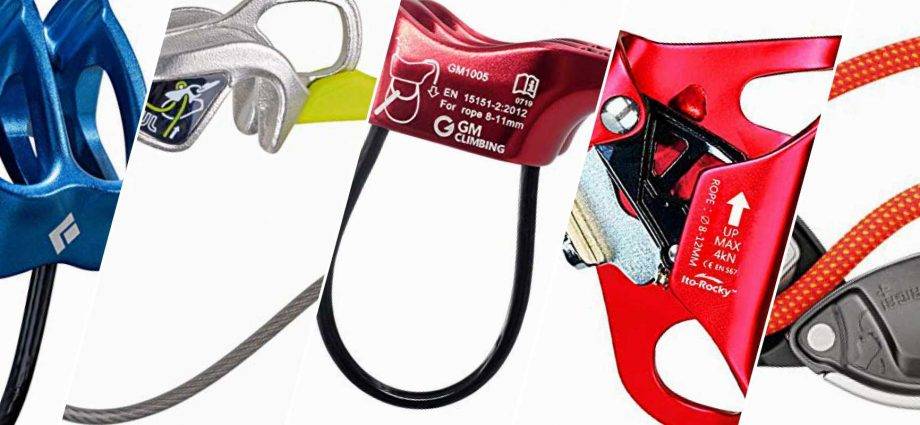- Black Diamond ATC-Xp Rappel
- EDELRID Mega Jul
- GM CLIMBING Micro Tubular V-grooved
- Ito Rocky Climbing Gear Ascender and Rappelling Descender
- PETZL GRIGRI with Anti-Panic Feature
|
TOP #1
Black Diamond ATC-Xp Rappel Belay Devices
|
|
TOP #2
EDELRID Mega Jul Belay Devices
|
|
TOP #3
GM CLIMBING Micro Tubular V-grooved Belay Devices
|
|
TOP #4
Ito Rocky Climbing Gear Ascender and Rappelling Descender Belay Devices
|
|
TOP #5
PETZL GRIGRI with Anti-Panic Feature Belay Devices
|
Black Diamond ATC-Xp Rappel Belay Devices
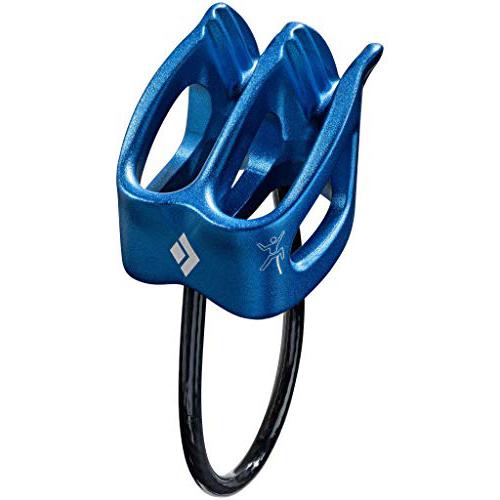
- Black Diamond Equipment: Designing and constructing the world’s best climbing, skiing & mountain gear since 1957
- Belay Devices
- Manufacturer: BLACK DIAMOND
- Type: Belay Devices






Lifetime came over the ATTC I, don’t even know when, like way before me- and that was your standard, tuber device and HTC means air traffic controller, because that’s what you’re doing you’re controlling the traffic over the years we have the ATC and then the ATC XP, which is like extra power with the teeth and then the guide, and then the sport, which is a single one.
For like gyms and single pics and stuff like that, but the ATC guide, it’s a really simple, functional design that works with a bunch of different size ropes when we’re developing something like an ATC guider, an XP or anything for that matter. We do all that comparisons of you know different ropes and how much friction does the teeth? Add your teeth definitely make a difference and then, of course, as the ropes get beat up and as the teeth get worn down, that friction goes down.
If you have big fat ropes or whatever you just repel this way and that you don’t use the teeth- and it’s great so super versatile, there’s some reasons why we put the whole orientation this way, because it’s kind of hard to do that, just when you’re manufacturing this thing. But you know if you’re belaying up an anchor and the ropes are coming up.
This allows it to rotate like this. We felt strongly about making it this way. I just think it’s such a super, versatile, functional piece, and now everyone calls it the guide. You know they want the guide mode and this the way that the the rope locks you know locks when you have it like this and you’re in guide mode. We didn’t invent that.
You know that’s from years ago with like these plates. That guides were using and stuff like that, but we just adopted it in order to this orientation. It’s just super functional and it’s just been really well adopted. You.
I’m Kolin Powick here at Black, Diamond and I’m, the Category Director- and this is the all new ATC Pilot belay device. This is a super cool new style of belay device for Black Diamond It’s really hard to talk about this thing;. There are certain words you’re, not supposed to say, like “locking” and that kinda thing In Europe they’re, calling this kind of belay device a semi-automatic, tuber So. This is a single rope tuber like an ATC, but it’s got enhanced.
Braking We’ve been working on it for about 18 months. This display here shows some of the iterations of how we got to the end point. Starting with this idea. Years ago, Black Diamond worked on basically grooving out an ATC; that was many many years ago, and then we kinda re-started up this idea. The goal was for single rope use from the gym climber to sport. Climber. Obviously, you can’t really rappel with it -. You can rappel with it with one rope –, but it’s fairly limiting So.
It’s really a single pitch kind of device. It gives you more security than a standard, tuber It’s, really just two pieces. There’s a 17-4 metal injection, molded stainless steel part which has really good, wear characteristics. And then a Grilamid® which is 20%, filled, glass, nylon, super durable, We, literally freeze these things and smash them on the ground and try to break them, but durability. Wise, it’s very durable, It’s, very simple This is good for 8 7 mm -, 10, 5 mm ropes, Every carabiner-rope combination is going to give you a little bit different, holding force We recommend using an HMS carabiner-.
You gotta have a big enough space to this can rotate around you wouldn’t want to use a little locker or it actually wouldn’t work that well. It takes about a pitch to really kinda figure out how smooth it is. And, it’s very secure, controlled, lowering Should. We check it. Out? Let’s check it out. Come’on follow me! So. The way it works. The rope is getting pinched in this V-groove by the carabiner So. You have your hand on the brake-rope and to lower a climber.
You just rotate it If. You lift this all the way up off. Then it’s very on/off like an on/off button And. If you do that and still have your hand on the brake rope, you can lower somebody no problem like that But, that’s not the way to do it and that’s not the point of it. The idea is for nice smooth, controlled lowering: hand on the brake rope and you just rotate it and it lowers (this weight. Isn’t too heavy of course) And? Then you know.
So that’s how you rotate it So the reason that you couldn’t use like a little Positron or a biner too small. It might not have room to rotate Right and if it doesn’t rotate, then you can’t lower the person. To top-rope, belay you’re, pulling in rope like this *Boom* hand, is always on the brake-rope. Climber is going up you’re pulling in rope And, then to lower the climber just rotating it again. One of the beauties of this thing for lead, belaying:, So I call it shuffling if you’re belaying, like this People call it shuffling Now.
You can do that with this [ATC-Pilot], but if you pull too much, it’s gonna seize up. The way that I, like belaying with this: your hand, is always on the brake rope, and then you can come up with your thumb. Just follow the rope up and you’re kinda, taking it off the carabiner and throwing out rope for slack and then, as the climber passes, the bolt you bring it back in And, then they’re climbing, you’re, feeding out you’re taking it back in They, fall *boom* And.
It’s really nice because you don’t have to remove your hand from the rope to do anything. You don’t have to do any funky holding of the rope in any weird way. It’s super intuitive, especially if you’re used to a tuber So. This is available in January, $39 99 and then it also comes in a package with the Gridlock carabiner I. Think for $54 99 The mechanics of this. You know we didn’t invent We, didn’t claim to invent that The Single, Rope, Controller I think was the first commercial product on the market, The Wild, Country, Single, Rope, Controller, (SRC) From at least the early 90’s.
If not the late, 80’s And, there’s the Mammut Smart, the Click-Up, the Edelrid Mega Jul. There’s all these other devices out there And. This is just our take on it.
Black Diamond ATC XP, this belay device is durable, light and well worth the price. Its features include high friction teeth, reduce weight with hollow sights and sizing at sports, 7 7 to 11 millimeter rope. The teeth mentioned before make the rope run really smoothly. Lowering must be done with two hands always will slide too fast.
This belay device is must-have for all sport, climbers.
If you’re looking for a climbing this personal guide, welcome to our channel at any time, you can click this circle in the corner and get more info and real time deals on your favorite products ready. Let’s start number one buy black diamond watch. This video choose your favorite number two another great product by black diamonds, number three get your favorite and climbing. Now just click this circle in the corner, number 4 number five, also buy black diamonds for more great related products for details and online deals.
Just click the circles. Thanks for watching this collection, if you liked it subscribe to our Channel, you.
Rock-Climb and grandma here in this blade dices that you can use when you’re climbing these three weather think they looked as earrings, no darling, hi I’m, a rock climber. Do you, like my jewelry, if you’re interested in checking out more about these, please check the links below I’ll leave you a link for all three of these thanks for stopping by, and hopefully you find some value in this video and if you do, I hope that you’ll click the like button below and maybe even subscribe, and if you want to be notified of some future videos coming up just hit the belt.
Ok first thing I want to share with you is the Black Diamond ATC. This is something I’ve been using for quite a long time. It’s really beaten up. It’s mostly my outdoor thing. Traditionally I have used this for ballet, but recently I’ve changed over to something else which I’ll show you in a minute, though new one that I have I, don’t like for rappelling. So this is my rappel device and it’s got two two tubes, so you can put two ropes in there.
It’s also got this safety wire on it. It’s got lots of scratches and dents from when I’ve used. It I wrote some stuff down on this card -. These are my talking points and I wrote that I can’t see anything and this little guy weighs in at about 60 grams. It will take a rope size that I believe is from 7 7 millimetres to 11 millimeters. Now, with any ATC that you’re using you’re going to be using a carabiner and, in my case I’m using the quick really simple to put on you, don’t have to worry about screwing on to make sure it’s locked.
However, you do want to kick that gate every once in a while make sure that it is fully locked. Alright, let me show you how to use this thing, so you want to take your rope and pop a Loup in there match it up to where your wire is and place it on your locking, carabiner and then a belay is just as simple as pulling out your slack making sure your right hand never leaves the rope and that’s a very simple way to the light.
When you brake, of course, you’re gonna have two hands on the rope: there’s no extra serration in this belay device. So it’s just tubes. There is a belay device, I’m going to show you next. It has a serration which aids in your braking system. If you want to use this, a rappel like I, do I put two ropes in match it to the wire and connect that to myself and now I have a little extra friction.
I can also do a fireman’s belay if I am rappelling the next ATC. That I want to show you chief. What’s that wait? This is what you get for, trying to film in erection. The next ATC that I want to show. You is the black diamond, TC XP. Now the nice thing about this? Is it’s got grooves in it, so the grooves actually assist in your breaking. This might be really good for beginners people just starting out, because it gives you that extra braking power.
It’s basically the same thing with two grooves. This guy comes in at 64 grams, and it can also take a seven point: seven millimeter up to eleven millimeter, climbing rope, weight, I’m sure I’m, trying to film at whoa. You can both play and rappel on this guy. In fact, rappelling might be a really good thing on this because of that extra braking power. I know I feel a little safer with the extra serration because I’m so scared of rappelling, in fact I’m a much more afraid of rappelling than I am of climbing or even falling.
So I think this is a good rappel device. This guy is also very easy to use just for a single rope when you’re belaying just pop that bad boy in there make sure that it meets the wire at the bottom pop it over your carabiner and you are ready to belay if you’re willing somebody that is heavier than you. This is a really good thing to use. It gives you that extra braking power and, of course, if you need to use it as a rappel device, it’s just pop to your ropes in there attach it and again you have that extra braking power.
It gives you a little more comfort when you’re coming down the side of a rock face. The last thing I wanted to show you is the black diamond pilot. This guy is amazing. I am so excited about this and it made outdoor rock climbing a lot easier for me because it saves your hand. This device is I’ll. Show you in a second we’ll, actually almost lock into place similar to a gris-gris. Although this is not a gris-gris, so I wouldn’t treat it as a greevey I treat it as an ATC.
However, the fact that it does lock into place gives your hands a little break when you’re outside neck cranked up to the sky. It takes care of your hand, so when it’s your time to climb your hand, is ready for climbing look who stopped by do you want to be? Do you want to be on you with he’s he’s running away where’d? He go I, so the Black Diamond pilot comes in at 86 ounces. I wrote some stuff down on this card.
It will take a rope from about eight point: seven millimeters to ten point: five millimeter. Now the other difference between this and the other ATC’s is it’s a single groove, so you’re not going to be able to fit two ropes in there. Obviously, the other thing that is different is this: has a plastic design to it, which, when I first saw it I was a little worried about, but, like I said before, this is like one of my favorite things to use when I go climbing outside, so may.
Show you how this works. I, wonder if this is called a limp. First of all, you do place the rope in there the same way that you would the other two ATC’s. It’s also got a little place to put your finger or your thumb, depending upon what your belay style is. Just like the other ATC’s you just pop it on to your carabiner, like that, it’s really easy to slip. Your carabiner, through the handle of this guy, just make sure that you’re going all the way through and all the way around your rope when you are connecting this thing and you believe the same way that you would any other device if your climber Falls, this is locked into place, I’m pulling on that, and it’s not going anywhere.
Of course, I would always keep my hand on this side, even if I have a green, green and that’s just good practice. So with that locked into place, all I have to do is keep my hand here. The pressure that’s put on my hand right now, I barely have to hold on, which is great. When it’s my turn to pull on some rocks, my hands, not gonna, be stressed out from belaying okay. So now your climber is ready to come down.
Some people have gotten stuck with their climber on the wall at the top I. Advise that if you have this belay device, you practice lowering before you get a climber on the rope. So basically there’s two ways to do. This. One way is to rock the APC back and that then releases the break and it allows the rope to go through. The other way is to put your thumb underneath the little lip when your thumb is underneath little lip you’re lifting the ATC off of your carabiner and allowing the rope to go through this way is really beneficial.
If you are leading now, I really do recommend that you practice this before you use it practice lowering before you lower and definitely practice leave before you leave, because this is a little bit different than a regular APC and it’s also a bit different than a gris-gris, and it’s better for you to have that practice before you have somebody on the other end of your rope, as I said before, I did leave links down below for you to check these out.
There’s links for each one and, of course, for my favorite highlight I. Hope you liked this video and, if you did, please don’t forget to like down below and if you’re interested in some more please subscribe, and if you’d like to know when the next one comes out with normally Sundays. Please hit the bell.
This is the Black Diamond ATC guide, blade of ice, and it won the guys Choice Award 2006, the ATC guide was predominantly tested by our rock guides. Those locations were basically in the Sierras North Cascades here in Washington State and as well as the Alps in Europe. Despite the ATC guide, beginning testing in 2006, it’s still used to date in our guide service equipment. Every blade of ice that goes out with our guides is an ATC guide, so it still stands up to the test of the years that we’ve been using it.
A few of the features that our guides liked in the ATC guide is the teeth which assists for blowing heavier climbers as well as catching people when they take big, falls the loop on the top of the device which allows you to hang the carabiner from an anchor station and bring up a second climber in Auto blocking mode. This mode allows the second climber to fall and the device to lock off automatically without any assistance from the Blair, and they also have made the device very durable.
So it stands up over years and years of use. We in fact, are still using some of the original ATC guides, since 2006 black diamonds actually lightened up the device by milling out the center and making it even lighter than the original device that we gave the award for. So even though black diamond cut out the middle of the device to make it lighter, it hasn’t really impacted any of the durability.
All of the high wear areas are going to be. You know in the areas where the rope is actually gonna be running through the device or where the device is hanging from a carabiner. So this lightning slot that’s in the device, actually has not really any high wear areas in it. So the strength of the device hasn’t been compromised and the durability device hasn’t been compromised. So, given that the ATC guide has these extra slots to add friction to your belay having to use gloves as a necessarily required, although gloves, wouldn’t be a bad idea when you’re actually lowering a climber in autoblock mode, the ATC guide is perfect match for an intermediate level.
Climber who’s, climbing multi-pitch routes, a novice or beginner climber- could use the device, but not use the auto blocking mode of the device to still be able to use it safely. The Black Diamond ATC guide would be a perfect match for any type of climate. That’s gonna be doing multi-pitch, sport or trad climbing. If you’re gonna be swinging pitches, the ATC guide is definitely the device you want to use.
You.
EDELRID Mega Jul Belay Devices
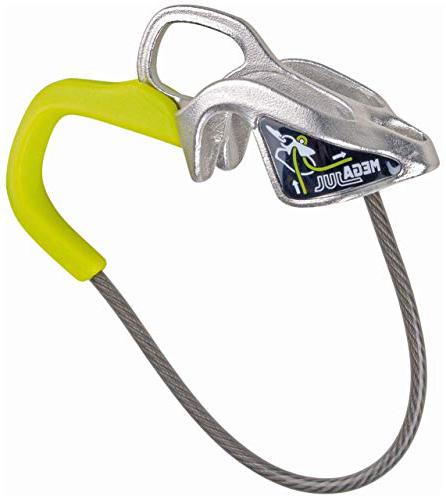

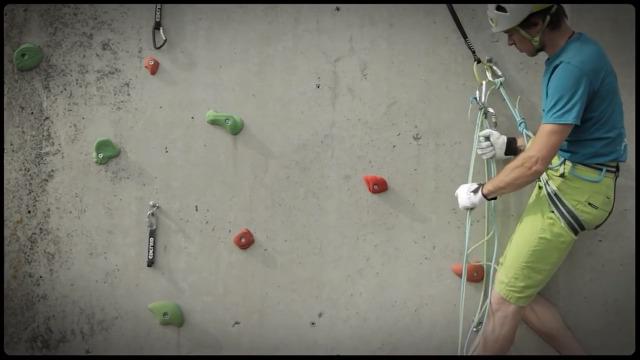
- For belaying a leader or bringing up 2 seconds, also suitable for abseiling
- Robust solid stainless steel construction
- Very lightweight construction
- High braking performance assists the belayer with leader falls
- Small eyelet for releasing unit with a carabiner when bringing up your partner
- Belay Devices
- Product Dimensions: 5 x 5 x 3 inches; 10.56 Ounces
- Item model number: Edelrid
- Manufacturer: Edelrid
- Type: Belay Devices





About our new belay devices, We have them on the market since one year already This is the Mega Jul. It works from rope diameters from 7 8mm to 8 3mm in double ropes and from 8 6mm up to 10, 5mm single rope use It’s meant to be a manual braking device, –it’s, not an automatic or semi-automatic belay device–. You should handle it or use it like any tuber belay device. The way.
We recommend to use it. Is: get the thumb in the thumb. Loop grab the braking rope, and then you lift the device a little bit and you can feed the rope when you belay somebody in lead, In, top-rope or when you have to take rope in you. Just do it like with any other tuber belay device. You can tunnel up the rope or you can match the hands and go up again. In case you have a fall. The device has very high brake suspension;.
Actually, it locks the rope I don’t want to speak of «, locking », because we don’t want to motivate people to take their hands off In. Any belay process it’s always necessary to have the hand on the braking rope. Lowering off then works with both hands on the braking rope. You can keep both hands on the braking rope. You go to thumb loop again and you lift the belay device to the point where it starts to slide and you can lower your climber off The standard version that we recommend for rappelling is in the non-blocking mode, so you have to function like any tube on the market.
Like this: use a prusik knot below and then you can rappel like with any other tuber on the market. You could try and see if it works with your rope in the other direction as well, but this is something I would recommend to train You clip it like this, like in belay and like this. It locks off again so it’s locked In case. You want to rappel, you can just twist it you go down In case you have a heavy rope hanging down below you, you go in with the carabiner and you can go over the cliff In the most case.
It will work, but it can happen. For example, if you have a stiff old rope- and you want to rappel on two strands of 10 5mm rope, it will be really hard to go down So there. It makes sense to use it in the normal method. In the standard, non-locking method, When, the rope is getting thinner and you feel the friction is getting less. You turn around and you have a much higher suspension, belay device In case you are in multi-pitch, and you want to belay two climbers that are following:, clip the rope in the guide function.
So on this you pull in and on this one it locks off With this device. It works exactly in the other direction than with all the other device on the market, because in case you would clip it on that direction. It will be locking in both directions. Nothing would happen, it would block, but you couldn’t pull the rope in because it would be locking The big advantage that it offers on the other side compared to many other tube belay devices on the market is it’s made from stainless steel – it’s not made from aluminum–, which makes it very durable.
Very strong So, it looks a little tiny but it’s much stronger than many of the aluminum tuber on the market. The idea behind started when we made a new twin rope, 6 9mm It’s, the thinnest twin rope on the market since last year. The ropes are getting thinner and thinner and thinner which make sense because they are getting stronger. They are as safe as ever, but we can make them thinner.
Now. The problem is, as the ropes are getting thinner, you’re getting concerned. Maybe “Will I be able to hold a fall. If somebody is really heavy?” So, we wanted to create a belay device suitable for a 6, 9mm twin rope and give some added safety in case of a fall And. What came out is the Micro Jul and as this one worked out so well, it was clear that we had to make a follow-up for double ropes and single ropes:, and this is the Mega Jul All the same functions we have in the Micro Jul, but the Micro Jul is design for smaller rope, diameters With, every pair of Flycatchers that you buy.
You get one Micro Jul for free It’s, always included in the package, because there is no other belay device on the market that would be suitable for that rope. Diameter I tried to make it as short as possible. Otherwise, I get complaints like “talking for hours”.
My name is Phil the head of product management at Edelrid, and that is the new Giga Jul looks quite similar to the other belay devices in our range, and actually it is also working the same way. So we have an assisted braking mode. It helps you hold the fall because it will lock automatically you see, you would still have to have control of the braking hand or the braking rope, but it locks automatically. But now comes the cool thing so, with the Mega Jul that we introduced a couple of years ago, there are a few drawbacks when you’re in an alpine environment and your climbing multi pitches, for example, to belay.
Someone from the station is not always very nice in handling. For example, when you would repel you had the possibility to also reverse the device and repel in a tube mode, but then, for example, if you want to get closer to the belay, to remove your carabiner, for example, it would lock those were situations where a tube device would be just better in handling than these assisted braking devices, and so we thought about. How can we somehow merge those two together, and we came up with this really cool principle here, which is that you have a slider in the middle and you can slide it up, and this way you have a tube mode, so you can change between assisted braking and a normal manual braking device and, as you can see, on the device, we have two braking geometries.
If I would just park this in the middle to see them better. You see here in the back. We have the tube geometry for braking, and here we have the assisted, braking mode and, depending on where my slider is I, can change between those we’re trying to get it below 100 grams. It is heavier than the Mega Jul, but I would still say from the versatility of this device. There is no other device on the market that has this variety of options: how to use it and still have really small and lightweight devices.
So the Giga Jul will be available from March 2019. It will weigh around 100 grams and it will retail at $49 95 US dollars and sixty five euros here. We have mostly aluminium, but the parts where you have the rope wear here in the braking geometries on both sides. We have a steel insert, so we achieve the abrasion resistance of steel, but combine it with the lightweight of aluminum. So this one has more similar geometry to the Jul 2 then to the Mega Jul.
So it works better, especially for a little bit thicker ropes. Then the Mega Jul, as I said there are some situations where the Mega Jul is not so comfortable in handling. One situation, for example, would be if you arrive at a belay, and you want to belay your second with the Mega Jul. You would have to put it in like this and then on a normal tube. You would come with the ropes from this side and with the Mega Jul, you had to insert the ropes from this side from the other side, so that was that was already like something you have to get used to and then pulling in rope, especially like a little bit.
Thicker rope was also not super comfortable, sometimes especially when they were a little bit older in comparison with the Giga Jul, you would switch the Giga Jul to the tube mode or the manual mode, and then it works like a normal tuber. So basically, you can go with the ropes not from this side, but just like you would do with your other belay devices from the other side and would be able to be belay a second and because also we have now an aluminium plate here in the middle.
Where the guide hole is we can position it slightly different, so the device will hang much better than with the Mega Jul, which gives it a lot more advantages in the handling of the ropes. Another situation is then, when my second climber arrives, how do I belay him when he starts lead? Climbing I have basically two possibilities: I can belay him from the belay point here or I can switch over to my harness to belay him from my body. If I decide, I want to belay him from my body.
I can just get off the device get it on. My harness and then I have him in the tube mode in the manual braking mode yeah, and that’s the easiest and fastest way if I decide I’m gonna belay from my body, but I would like to have the additional safety of the assisted braking mode. Then I would need to get off the rope switch onto the the assisted braking mode turn the device around put in the rope on my harness and now I can belay him like I I also do with the Mega Jul and I have the advantage that it will lock and help me break or help me hold a fall.
I could also belay someone from the belay station. This is, for example, has an advantage if there is a potential that, in case of a fall, I get yanked up and maybe lose control of the braking hand. So, in this case, for example, if I climb with a heavier person, I would recommend to belay from the belay point, and here I can also decide to belay someone in the assisted braking mode, but then giving out slack can be with handling sometimes difficult, because, of course it can block and I would have to release it.
Then, of course, I can also again flip it around. Have it in tube mode and then insert the rope and now I have really nice handling and in case of a fall I mean I, have the possibility to hold the fall in the last situation, or the third scenario is repelling here as well: I have the possibility, of course, to rappel in the assisted, braking mode and but I could also rappel in the tube mode, and that was again as well. The case with the megajoule I was able to belay like this and I was able to flip the device around and have more of a tube function in rappelling, but the drawback here was, if I want to remove my carabiner now and I would like to get closer to the belay point.
It would look sometimes, and it would be harder to do it with the Giga Jul in the tube mode. I would usually back it up with the prusik, but then I can easily get close to the belay point. Unclip my carabiner and then start repelling again. I’d say the advantage of this device is, if you put the rope in the wrong way or, for example, don’t turn the device around. You always end up in a tube mode. So the worst thing that you get is still a tuber or like a manual braking mode.
Nothing really can happen where you say now: you’re going to lose any type of friction or control over the rope.
Hey guys I’m here with another blade of the past, the it’ll read megajoule, and so essentially this is a tubular device as two holes, so you can do bling repelling on it. It’s made by a company in Germany, it’ll, rid and I, really like what the company stands for, because they’re all about saving their environment and trying to make these devices to last.
So something that’s a bit different than from this device, then from an ATC or many other belay devices on the market is instead of using an aluminum, alloy sort of blend. This is made completely out of steel, which is why it’s so thin, especially in that little nook right. There is because the material is a lot stronger and it also lasts a lot longer.
So, if you’re, using their ATC, for let’s say four or five days a year and a climbing season for at least six months, you’ll probably have to get a new ATC after that season. Whereas this will last you two or three and and that’s the big thing. A lot of it’ll ribs materials are built like that. Like they’re, quick drawers with that steel insert a lot of their carabiners, that steel insert and even some of their other carabiners, even like this one, which I used for nearly a half a season for my rappel bener, and it is barely any wear on it at all.
So I really appreciate their company and how they’re trying to make this stuff to last. The device itself actually has a lot of mixed reviews. It seems that, though, people either really love it or really hate it, and it’s kind of funny I’ve been using mine for about six or seven months now off and on multi pitching single pitch climbing.
Just you know experimenting with it to try to get this. Video going and I do have some thoughts about it and I’ll sort of spill. Those in as I go with the video, but this this device tends to you know, have some following behind it and let me just launch into the review I’m gonna start with how you can load it on your harness for lead climber, how you can use it in bling from above and repelling and then give my final thoughts about it.
So here we go so here: I am with the device ready to go and I wanted to talk real fast about the carabiner to use with this gadget. So this is a non-mechanical brake assist device and what I mean by that is the wrong way. There we go. Is that um? The way how this actually cams up on the rope is the plate gets forced against the carabiner right here along that little groove, and so one is be careful about the care-bear.
You use I’ve used a couple different carabiners with this, and they all seem to work, but um, maybe a bit of a thinner one will help get a tighter grip on the rope. The carabiner I got right here is one I really don’t use too often it’s actually made by it’ll rid it’s a strike. Slider carabiner! You can see how the lock is right here.
You open it up technically counts as a locking carabiner, but um I have a couple stories about these, which I’ll save for a different video as to why I don’t really use them too much, but it also has this little wire right here. There are a number of these carabiners on the market, just to keep the carabiner oriented on your belay loop to keep from cross loading, and it may be best, especially if you’re, using this for morally bullying or a single pitch stuff to have this carabiner, because one thing we do sort of want to avoid with other carabiners here, let me just pull a random one off.
My harness, like the magnetron, is flipping around. If the carabiner does flip around which it will do while bowling and it may affect the pinching on the rope or the you know, the camming brake assist action depending on the carabiner you use, especially if this point is really is really pointy that can affect the pinching on the rope.
So that is something to watch out for that’s. Why I’m going to use this specific, carabiner, all right cool, so the way the rope goes into it is. If you look at the device, they actually helps you out with pictures right here, I think yeah, here’s the one for belaying the lead climber. Basically, you want this green loop to be where your thumb is the thumb your thumb up, do the break, and so by clipping it on and then here’s my rope, I’ll thread it through, like I normally would through the plate, then take the carabiner and lock that one.
So that way, both the the keeper strap and the rope are in the carabiner and what I’m going to do this easier to see? Here’s my climber strand going up and then here’s my break strand. Here’s my break hand on the Strand and then what you do is you hook your thumb in the little green loop and then you hold the plate off of the carabiner and that allows you to thread out rope real easily, taking in rope also very easy, as long as the device is hovering above the carabiner.
If the climber were to fall, you see how that forces the plate up against the carabiner and that’s what in axe or that’s. What creates that brake assist feature in fact, here, I’ll just hold onto the climber strand, and you can see how how effective that brake assist is because I don’t have any brake handle on the rope or anything.
You can see how it is holding my weight that I’m putting into it. This is actually one of the better brake assists for this type of non-mechanical device. I’ve seen with the different devices I’ve used, so a cool thing about what it’ll ridden says and I got this from an actual littler drip is when you’re, paying out slack, really pull a little bit more rope through when you’re paying out slack.
Just keep your thumb in the loop. Keep your four fingers right here on the brake string. You just keep on paying out slack and another cool thing is, if I flip over, if the climber Falls, while your thumb is holding this up, is it supposed to actually force still go into the locking position which is kind of nice compared to other types of devices like these on the market, but other than that? You just keep on playing the exact same I personally have found that when a climber has fallen and I’m holding this or like they just want to lower after they’ve fallen, it is a bit annoying to try to pull this out when you want to lower a climber.
All you do is take the thumb, loop and push it away from you and that all you want is the separation of the plate between the carabiner, and so once you achieve that. That’s when the lowering starts happening, but personally I do think it’s a little hard to engage that, especially if the climber is heavier than you and it’s a decent-size ball.
So one thing I end up doing is I have to put both hands like this or, if I have my brake hand on the thumb. I’ll put my other thumb in the same hole and then pull it out, and that’s just something that you sort of have to feel for yourself other than that. Lowering a climber is just the same. All you do is pull this out and then the Rope will start sliding through again with your first time, taking nice and slow.
So that way you can feel what’s happening with the device. So here you can see, I went ahead and I just stuck a bit of weight on my anchor right here. So that way you could see the device when it’s fully locked up and I have my brake and on my thumb’s in the loop when I want to lower a climber I just pull this out and the Rope starts sliding through there you go and then again it just takes a little bit of practice in order to get that whole system smooth, and it is a lot easier with a backpack than an actual person all right.
So now, let’s talk about setting us up belay from above style. I have my megajoule right here and I actually switched up a carabiner from the last one to a different one, without that little gate right there, because I think that’s kind annoying in this application either way. Here’s my other carabiner that it’s going to connect the device to the anchor here’s.
The megajoule this ring right here is the same ring that you’ll hang the device off of. While you thread your rope through and now this can be where it gets a little confusing the picture may focus or it may not. You can always go on to it already website to see this, but this picture shows you how you’re supposed to load this device when you’re blamed from above and I’m gonna show you that in a little bit right there, but that it helps out with the guide when I first use this, like the first ten times or whatever I had to look at that guide a lot but either way so I clipped the device to the anchor through that ring.
And now let me show you how to load the rope into it. So here’s my climbers end give it a little bit of space and instead of going from the top like we did when we were elite blowing, we’re actually gonna go from underneath push the rope up and grab your locker and then there you have it yes see how that is, and so you can always test by taking the climbers in giving it a tug.
And if you can’t pull the rope through then you’re good to go and you can pull on the Blair’s and to see if the robot you does slide through. So that’s how Helen the instructions on top they show you to set it up. I mean like right here, but I was actually talking to a representative that the Idul rid and recently they’ve changed this and the reason.
Why is when the climber sits? You can see how the ropes are well. This is also really thin rope I’m using but I’m using it to demonstrate how there’s that possibility of the same possibility with the gg for these ropes to actually flip there you go. It’s actually really easy for me to do that, and now the climbers end is not actually breaking so the way how you get around that problem is again.
Here’s my climbers end right here: I’m gonna, pass it up through the device and I’m going to bring the rope down, and this can get a little tricky. This takes some practice. Let’s see, if I can do it flip all these mmm almost lost it. There clip all these and then that first string of the loop and you got to rotate the carabiner so that way the gates, not on the braking side.
There you have it so you’ll notice that, just like the Gigi, the carabiner is wrapped all throughout the belay device. Yeah there you go and now I can pull on the climbers end and rope slides through alright sorry I can pull on the brake side for up slides through just fine, but the climbers end it locks up and because of that, carabiner being attached to the system like this there’s no risk of the rope flipping and and that’s the idea it does take a little bit of practice.
I’ll try to shoot it from another angle, so that way, you guys can see see that again because it it’s a little confusing at the start. But if you just practice with it, you’ll get better and you’ll sort of see what I’m saying now, just like the GG. If you want to set up your megajoule with twin ropes, then you don’t need to have the carabiner threaded throughout the device like that, because the twin ropes by having the two ropes, it’s not gonna twist on you, so that is a little bit of a nice part about twin ropes, I find personally at the amount of pole when the carabiner setup, like this versus the other method, see if I can just quickly do that.
The friction is about the same so me personally, just to be in the realm of good habits. I tend to always set up my the megajoule or even the GG I always set it up like this, just for good habits and being fresh and the mind-bending trick of trying to set that whole rope system up. But that’s how you do it with twin ropes.
So now, let’s talk about rappelling with the megajoule, there’s actually two different ways: you can do it one with the brake assist and the other without which is a very nice feature to have to set it up with the brake assist. You have your two ropes just like so take the loop and it does help to have it clipped to you, but just so that way, you guys can actually see it and then thread it in the same way as you would for a lead bilang onto your belay loop and then now you have the brake assist feature.
If I can there, we have it so, depending on your rope, you will have some slippage this one’s really thin. So I got a little bit of slippage here, but as long as you just hold on the brake strand like you’re supposed to do, that’s not really a problem, but you still have a help with brake assist and in order to lower yourself, you just grab the thumb and pull out and down you go.
Some people prefer to rappel with the brake assist. I personally don’t because I find it just gets in the way, especially since I like to do a rappel tether with an extension when I rappel, so I don’t tend to do brake assist and then so what you do is, instead of loading it with your brake hand, again we’re gonna thumb is just flip.
The whole thing around it’s actually very simple and very ingenious. I got to hand it to them thread it through same thing: two holes flip the Locker in right there and now slides, just nice, no added brake assist feature or anything like that. So that’s a very nice feature me since I, like doing extended, repels with a third hand already the extra brake assist is unneeded, and so I can just flip it over and then act like a normal tubular and belay device to get off the wall, which is a really nice feature.
So final thoughts on the Edward megajoule I think it’s actually a pretty good device. I think it’s nice to have in your quiver, for whatever you need, whatever you feel like, you need it for me personally, I, don’t think I would use it too much single pitch climbing, especially not where I’m playing someone I think is gonna fall a whole lot, mainly because it is actually really annoying after they’ve fallen and the the device is tied on a carabiner to pull it out and maintain a steady, lower, I feel like it.
It just sort of grips the Rope a little tight and if maybe they sat down on the rope like they took and then lowering them down, it would be a bit nicer and easier, but after they’ve fallen. Lowering is someone it’s kind of annoying on this device. Multi-Pitch climbing I actually bring this out multi-pitch climbing a lot, but only when I’m using twin ropes and that’s either for playing my friend, you know lead bilang them in order to have the brake assist, which is kind of nice on twin ropes or maybe not so much bling them from above, because a lot of times I’ll have my ATC with me and I’ll.
Just use that, because it’s a little bit easier to deal with as well as it’s a little less friction pulling through, but bling Liebling with twin ropes. This is probably my go-to device, because it is a lot less work than you know. Two arm lengths with the ATC versus just the one with this device and so I feel like that’s.
What I would do is multi bit climbing with twin ropes. This is gonna, be on me. It could very well be the only device. I bring that’d, be fine, but I’ll probably also have an ATC with me. While I do this, it’s also very nice for guides, because this, since you can have your thumb, holding it up and it’ll still lock up.
If, if the climber Falls, if you the climber Falls, you can give this to a very inexperienced player like a client of yours that you maybe just taught to play earlier that day or earlier that week and you can feel pretty secure if you were to fall on this device, especially with how much the pinching action works in the assistive braking action works, especially on slightly thicker ropes.
The ropes are using the demonstrators, seven point, eight, so they’re both half ropes. So if you have like a nine mil or nine point, two or nine point six which I use for guiding in this thing, then it’s gonna pinch pretty hard. Even if the client didn’t really understand what was going on in the event of a fall. So this is a really good device to have all guiding and that’s the reason why I always have this.
Actually in my backpack in the very bottom, while I’m out working is if I, if I, have a nun sore on not untrustworthy, but just a less experienced client I can give them this device and feel a bit more secure than what I’m doing, but other than that I think it is a very nice device. I think it’s maybe more of a secondary device so again learn on a non assistant, breaking tubular device like the pencil reverse or the Black Diamond ATC, and probably hold one of those for whatever you need.
And this would. This would be like the device to learn how to play on because of all the extra functions and features and how it’s high-tech and more difficult to deal with at times so I I feel like it would be good device for an experienced climber or even just you know, a smaller amount of experience. But you Nia has some experience that deal with the extra bells and whistles on this device, even though it looks very simple, just being a small piece of metal but dealing with it.
The right way you do want to have some experience, pulling I wouldn’t give this to a person I’m teaching how to belay unless they’re I’m, just working with them for a day or so in that guiding sense. But if I’m teaching someone to blame for you know for their entire life, I’m gonna give them something a little bit different to start off with either way.
That’s my final thoughts again. I think this is definitely worth having, especially as like a backup device or anything like that, but I just it has a few more complexities to it. But but there you have it. That’s the it’ll rid megajoule.
Today, we’re taking a look at the new megajoule from L R it it’s lightweight. It’s constructed play device that functions from a rope of seven-point eight millimeter to ten point. Five, the lightweight steel construction allows for a rapid heat dissipation. It has either single or double or half ropes. Whatever you happen to be using, it takes the diameter from seven point, eight millimeter to ten point.
Five, and now let’s go ahead and take a closer look at all of its in detail, features first off we’re just going to take a look at a standard. Single rope lead delay situation, as you can see. There’s this groove here in the device that will match up with the this is critical in the locking motion right now, I have my thumb through the release lever pulled out which allows for quick and effortless feeding of the rope to your climber or if you’re rappelling, you can unlock your rappel device and, as you can see here, I’ll demonstrate the locking of the device so go ahead and fall climber, as you notice here completely locks now.
Could it be hands-free? You always want to keep your hand on the brake line anyway, but the point is is that it is now locked and then, in order for when my partner’s ready to climb again, you just lift up on the lever and you’re good to go effortlessly one more time go ahead and have my climber fall one more time lately locked. Of course, the fall would be a little bit more dramatic and showing this he’s just pulling on the river but yeah.
One more time now we’re demonstrating the lowering of your wiener after they’ve arrived at the anchor. So once my leaders made it to the anchor he’s going to weight the rope which will lock it, as you can see here and I, have my hands on the release lever and what I’m going to go ahead and do is just slowly start to relieve the pressure and it will just slowly begin to lower my partner.
This is similar to any of the devices on the market. You just adjust the pressure to, however fast you wanna, lower your partner, always maintaining your hand on the brake I’m going to show you another method for lowering your partner. There’s two methods: I just showed you the first in this method, my partners again just made it to the anchor the device locks off as he waits the road in this method.
Previously I had my thumb here and apply pressure upward like this. However, you can also do it like this, which to some people is better, but you just pull up like this now also release to a desired. You can put two fingers in here if you need to desire the our fashion, while lowering partner now here I’m going to demonstrate the repeal functions of the editor in mega Joule. So this you saw earlier in the video has an auto locking feature so right now, I have it in the auto lock function, so I can go hands-free again recommend you should always have your hand on the brake line, but you could an emergency if you need to do something, this will completely hold you and once again, here’s the release lever.
So, as you can see, this is my full body weight and in an overhang. So this is about as much force as I would ever apply, and it’s effortless to release it. Now, if you wanted to, you could flip this around, which will show you here in a minute and have it just as a regular, ATC, repel device, I personally like to repel with the security of the auto locking just in case I, need to do something or if I lose control the rope um or if you need to ascend back up.
You know it’s nice and easy because it just locks nice I’m, going to go ahead and show you it’s not in the auto locking mode, but it’s just in the freehand regular Maya physical force is what’s locking it off now, I. Have it in kind of your more standard, non-locking mode, that’s similar to many of the devices out on the market today in this function, since I, don’t have it in the auto.
Locking mode should use a prusik to back it up. Of course, that’s the beauty of having it in the other mode, so you wouldn’t need a prusik in this function. Basically just functioning in a standard manner, I have my hand on the brake hand and lower myself. Here we have the mega Joule and guys set up with just demonstrational, acre, obviously with only one sling. So basically the mega, Joule and guide mode is set up where this ring right here.
Locker in this locker takes place of this provider. Your believe, it’s gonna be responsible for applying pressure to the second balls autolog, which is nice to make first, a quick, whatever run longer to organizing something you can do a weighted either. Eight full on this Manor. The best way take locker anything put it right through the nose lower them back. This gives you more leverage, you know.
Do it the classic way by just pulling on this -? For some reason, they’re heavier have to go in through all the features now I’m just going to give a quick summation on the device. Well, I think it’s so great as you’ve already seen it’s extremely versatile, but amongst its best qualities, is the peace of mind that you’re going to get from this, as you would get from any auto locking device.
But you can take this one into the Alpine with you. You can take any place that you would use more of a traditional device that you need to repel with anything like that, the peace of mind being that especially an Alpine or anywhere. If your partner gets knocked out or something you can pass to see, if a hands-free, just it’s always going to catch my partner, so I feel better climbing my partner has this certainly do, and previously the only devices that we do.
This, for me would be the heavy booking, auto locking or belay devices, and this is super light you can rappel with it. So far, it’s new on the market and I’ve been using it an alt rain ice mixed Alpine, trad sport and has passed all my personal tests and I love it. It’s extremely versatile, lightweight spray is an extra backup blade of ice on big wall, climbing or longer routes, because it weighs 65 grams, which you can’t beat that happy.
Climbing.
Hello, my name is Moritz Today, we’re going to take a closer look at the Jul2 The Jul2 is an “auto-tuber” made out of stainless steel. That is perfectly suitable for sport. Climbing top-roping, single pitch climbing in general and also gym use It can work with rope from 8 9 up to 11 millimeters Therefore. If you have a fuzzy 10mm rope, it will work smoothly and will be an enjoyable experience to climb with It works in similar ways as the Mega Jul, meaning that there are no movable parts and it’s purely based on its geometry.
What’s happening here is that the dangling rope tilts the device and the carabiner locks into this groove, therefore creating a passage that is too narrow for the rope to pass through and locking it off. To get lowered, I just put my thumb in here and can lower him really smoothly due to the increased sweet spot that I have because of the bigger lever and the good leverage It definitively adds extra level of safety to the whole belay system.
For demonstration purposes, I took my hands off the brake line. Never do that in real life. You should always have a hand on the brake rope, If you’re, trying to lower someone with a lever and things aren’t as smooth as you expect them to be. There is one trick I’d like to show you – which also works for the Mega Jul. By the way – so you put your thumb on the back point the finger through here and you gradually tilt the device, and then you can lower really smoothly and easily And.
This might be especially interesting if there is a big weight difference between climber and belayer. The device is made out of stainless steel. Therefore it won’t wear out; you’ll only have to buy it. Once; you’ll never have to replace it because of wear Yet. The carabiner will wear out since it’s aluminum and the rope runs over it and after excessive lowering and whatnot you get this big groove there and every half year, you’ll have to replace a carabiner, which is why I am actually using a steel carabiner here.
You might think: “I am not going to use a steel carabiner it’s super heavy” – in my world, I think: “It doesn’t make a big difference if I carry an ounce more or less to the gym. ” The strike screw weighs in around 70 grams The steel carabiner weighs in around 110 grams 120 grams, so it’s not that much of a difference.
And this carabiner won’t, wear out so I can highly recommend to belay off a steel carabiner. Even if it’s something you haven’t thought about. Yet We already showed the Jul2 at the last show. If you remember it had a plastic coating all around and the functionality was a little bit different, The version we showed last year – which never made into production – didn’t lock off the rope completely;.
The idea was, there is still some slippage involved. Our philosophy now is, and will be, for the future to only have fully locking tubers only auto-tubers No, more Kilo Jul, no more Jul only Jul2 and Mega Jul;, and both of those lock off completely.
GM CLIMBING Micro Tubular V-grooved Belay Devices
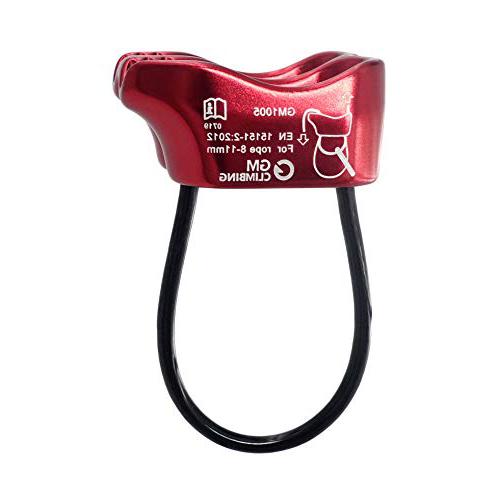

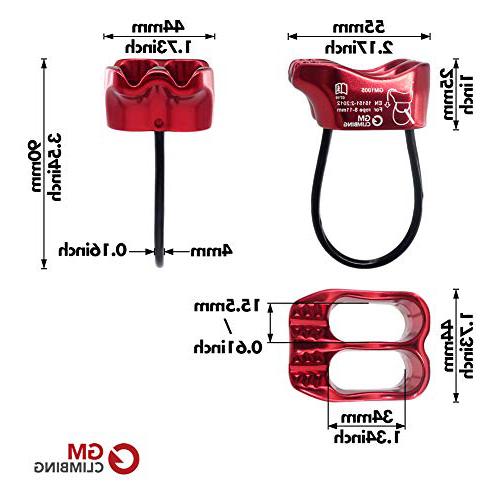
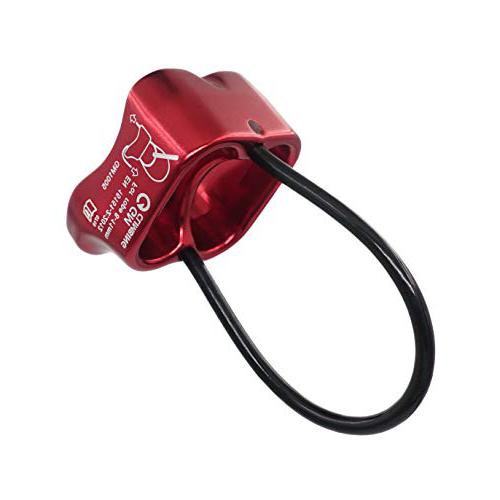
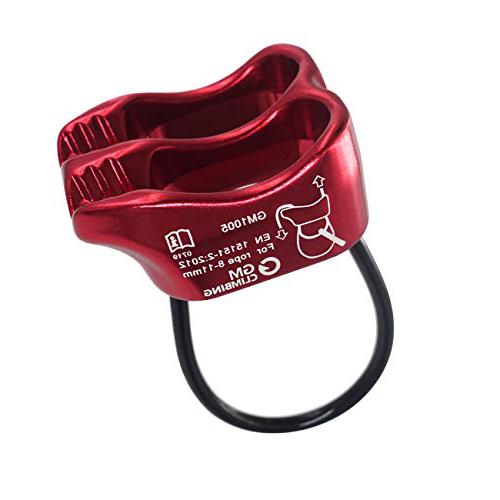
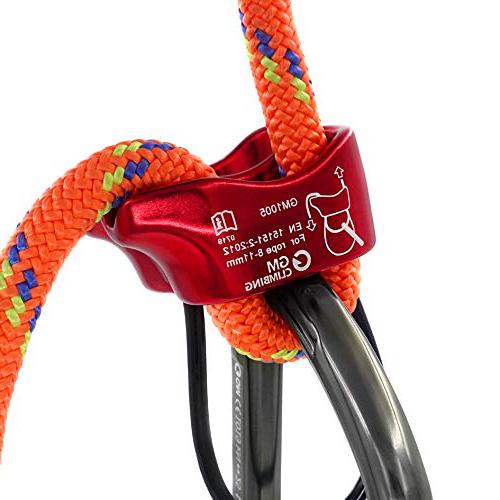
- GM CLIMBING V-grooved Tubular Belay Device: light and compact, smooth rope control, EN 15151-2 and UIAA certified. THIS ITEM DOES NOT INCLUDE A MOUNTAINEERING CARABINER
- LIGHTEN YOUR RACK! 2.24Oz, an ultra-light, compact and easy-to-use V-grooved belay device with teethed channel, IDEAL CHOICE for you climbers to lighten rack.
- BETTER ROPE CONTROL! Whether you use belay device in belaying climbers or rappelling, TEETHED CHANNEL creates more friction in braking and allow device to work with skinnier rope. With minimum force, you can easily arrest the fall of climber promptly.
- Versatile in single rope also double ropes belay with twin slots; Compatible with rope 8~11mm
- Highly efficient heat dissipation realized by light aviation-use aluminum alloy.
- Belay Devices
- Manufacturer: GM CLIMBING
- Type: Belay Devices
Ito Rocky Climbing Gear Ascender and Rappelling Descender Belay Devices
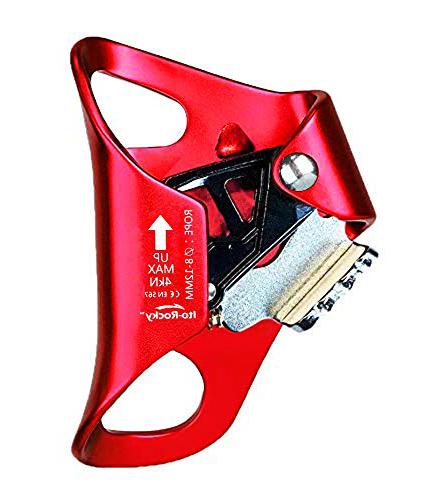
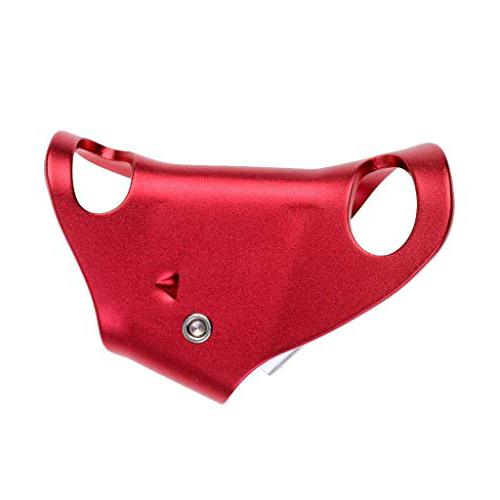
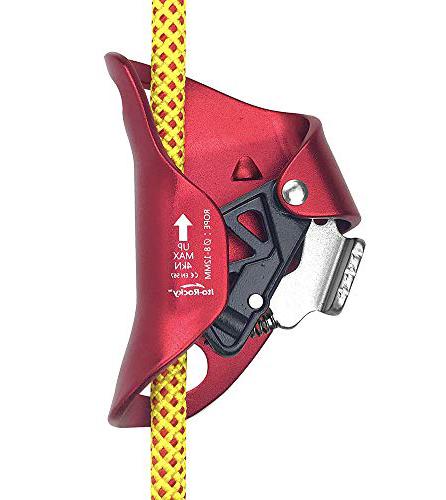
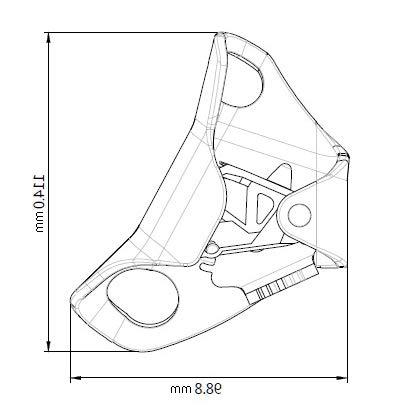

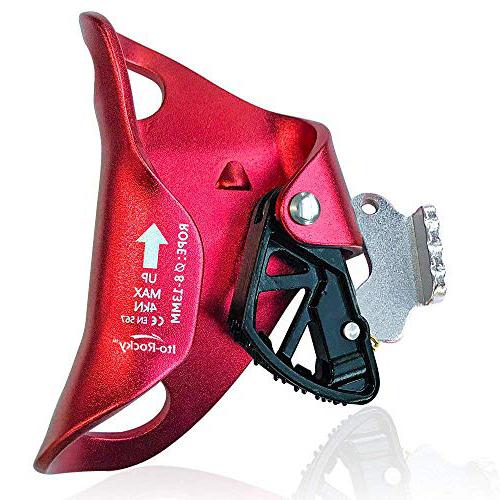
Self braking in case of accidental loss of descent control. Sensitive handle enables smooth descent without harmful rope twisting. Also suitable for work at a height and for emergency self evacuation.
Specification:
- Designed for rope ascents, the Ito-Rocky ventral rope clamp is simple to use, thanks to its pinch opening system, which is totally integrated in the clamp to avoid any involuntary snagging. The attachment holes ensure efficient positioning during ascents.
- Application Strategy: Used with a BASIC ascender or with an ASCENSION handled ascender for rope ascents.
- VanStone climbing Ascender provides comfortable and excellent grip in compact shape, much improving ease of climbing with no need to grip rope with your hand.
- Toothed cam with self-cleaning slot optimizes performance under any conditions (e.g. frozen or dirty ropes), Magnesium alloy forging cam has better resistance to corrosion. Magnesium alloy forging wear plate for improved durability.
- Weight: 0.35 lb. Rope: for use with single ropes between 8 and 13mm. Certification(s): CE 2008 & EN 567.
- Belay Devices
- Manufacturer: Georsh
- Type: Belay Devices
PETZL GRIGRI with Anti-Panic Feature Belay Devices
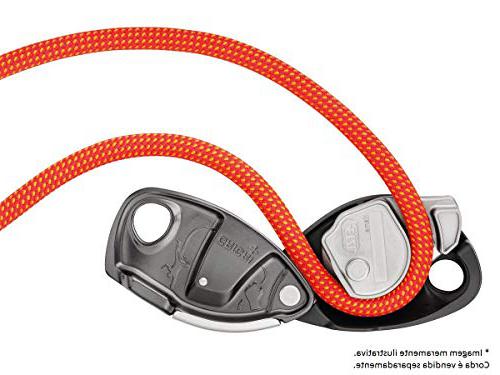
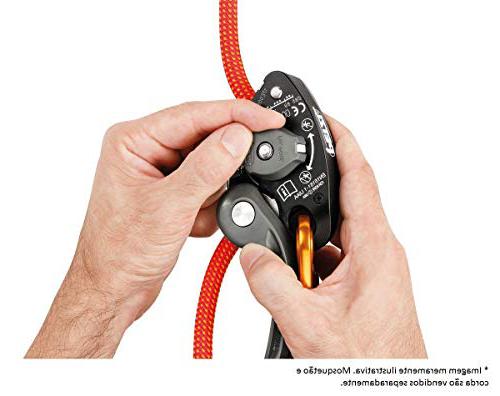
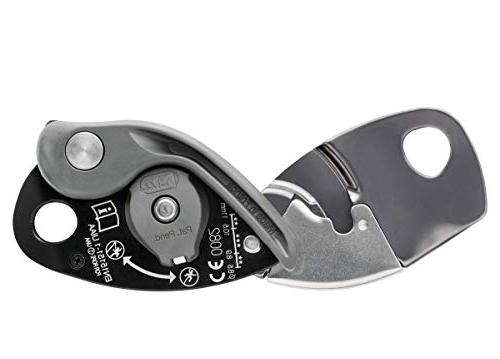
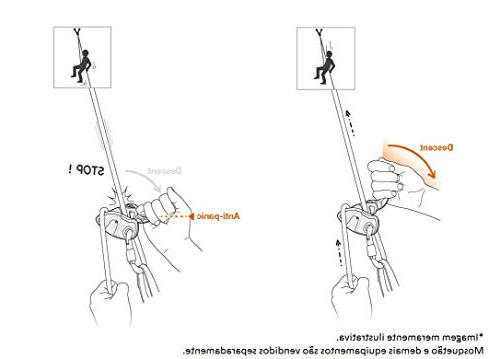

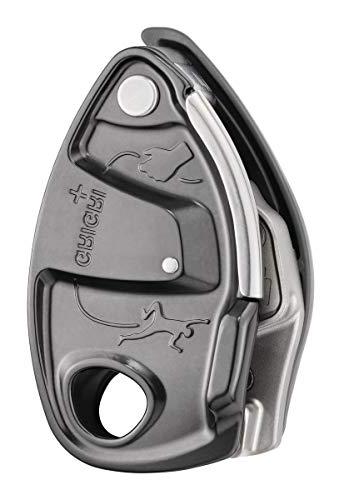
The Petzl GRIGRI + is an assisted braking device designed for all climbers, for both indoor and outdoor climbing. It can be used with all single ropes (optimized for 8.9 to 10.5 mm diameter ropes). Offering great durablity, the GRIGRI + is suited for intensive use thanks to the stainless steel wear plate. Hand motions are the same as with classic belay systems. The reduction handle offers exceptional descent control. Two usage modes to choose from, depending on need: top-rope belay or lead belay. The top-rope belay mode and the anti-panic handle make for a more comfortable belay, making the GRIGRI + particularly suitable for learning. Diagrams for rope installation engraved on belay device (interior and exterior). Weight: 200 g. Material(s): aluminum side plates, stainless steel friction plate and wear plate, reinforced nylon handle. Certification(s): CE EN 15151, UIAA. 3 year manufacturer guarantee.
- Belay device with assisted braking and anti-panic handle, for all single rope diameters
- Suitable for top-rope belay or lead belay
- Anti-panic handle for a more comfortable belay & learning
- Aluminum side plates, stainless steel friction plate and wear plate, reinforced nylon handle
- For use with all single ropes (optimized for 8.9 to 10.5 mm diameter ropes)
- Belay Devices
- Manufacturer: Petzl
- Type: Belay Devices

